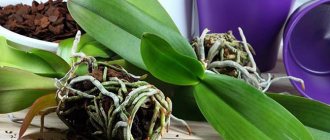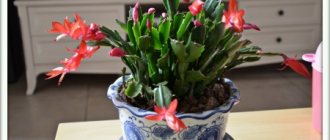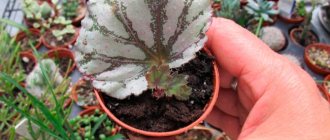When is a transplant needed?
The plant really needs replanting. As the roots grow, they gradually fill the container where it lives. There are several cases when a transplant is required:
- roots appear from the drainage holes and extend beyond the pot;
- the plant is sick, depressed, and loses its decorative properties. The leaves turn yellow, fungal infections are detected;
- the appearance of pests in the soil, including the possibility of egg laying;
- The old pot has become unusable.
Begonia in bloom
In some cases, the plant has not yet reached large size, but the pot was found to be completely filled with roots. This means that the time has come to change the container. Begonias that have not yet mastered the entire capacity and are healthy are not transplanted.
There is another case when replacing the pot is necessary. The flower is provided with another pot and fresh soil. The begonia plant needs replanting after purchase. It is not recommended to rush through the procedure, but in a store-bought container the plant will sooner or later wither.
In what cases is it necessary to update the soil?
On a note. No matter how rich the soil in which the flower grows is in nutrients, it needs to be changed.
This is due to the fact that with prolonged use of soil for growing begonias, it is depleted.
After transplanting the plant into a new substrate, better conditions are created for its growth. In addition, by using a pot larger than the previous one, more space is freed up for the root system and oxygen access to it improves.
There are several ways to determine the need to transplant begonias:
- Those plants whose roots have begun to emerge from the drainage holes are subject to replanting.
Take the begonia in your right hand, cover the soil with your left hand, turn it over and lightly hit the pot. This way you can remove the container and assess the condition of the earthen coma. If during inspection it is clear that the roots are entwined in a lump, then this is a reason for replanting. If the roots do not reach the surface of the coma, then the plant does not need to be replanted; it should be placed back in the pot. - It is necessary to replant a flower if there are obvious signs of disease, yellowing of leaves, or acidic soil. You will learn about what to do if begonia leaves turn yellow and dry here.
How often to replant begonia?
The transfer of the plant from the old container is planned in early spring. This choice of time of year is the most correct, because growth processes are just beginning to intensify. At this time, the indoor flower will endure the procedure and recover with minimal losses.
Important ! With excessive growth of the root system, the risk of injury increases. This situation cannot be allowed to happen.
Experienced gardeners believe that changing the container and soil should be made an annual event. This is due to the fact that the soil becomes depleted over time. The plant is given the opportunity to restore its composition, replenishing it with the necessary nutrients. It is better not to forget about the regularity of the procedure in order to avoid death.
It's time to replant the begonia
There is another important question: is it possible to replant begonia that is currently blooming? This should be done only after the flowering process is complete. Then the procedure will be safe, otherwise the flowers will begin to fall off. There is a possibility that the plant will lose its decorative qualities, taking on a sickly appearance.
How to plant a plant?
With the onset of spring, begonias that grow as bushes need to be planted . To do this you need:
- Remove the plant from the pot.
- Remove overgrown stems, peduncles and large castings. Carefully wash the root system from the soil with water.
- Using a sharp knife, break the bush with roots into pieces so that each individual plant has a bud or sprout.
- Sprinkle the cut area with activated carbon.
- Treat the roots with Kornevid, plant the plants in pots and water.
How to choose a pot and soil?
A competent choice of container and soil will be the key to health for begonias. This is the most important factor in the question of how to replant begonia. You need to make sure you have everything you need before the transplant event. The list of components is as follows:
- a suitable pot should not be overly large. Young begonias are transplanted into containers that are 3 or 4 cm larger in diameter than the previous ones;
- The material of the container is important. They prefer ceramics, although plastic is also suitable for creating the necessary conditions;
- When deciding how to plant begonia, for each part they take containers 2 or 3 cm smaller than the previous one. When separating the rosettes, the original plant is left in its original container. Technological pots have a size of 6 by 6 cm;
- soil mixture of suitable quality. This is a mixture of peat, turf, humus and ordinary soil in equal proportions;
- drainage as the basis for comfort. They take expanded clay, crushed stone, pieces of foam plastic and other materials.
Having prepared the listed components of the process, they begin to transfer the plant to a new place of residence.
Begonia in a new pot
Important ! The shape of the next pot should not create additional difficulties. For example, if the edges are curved inward, it is easy for pests to hide there.
Blooming begonia is not replanted
Soil disinfection
There is one nuance in the question of how to properly transplant begonia at home step by step. It is important to disinfect the soil, which will ensure the absence of pests that can attack the plant from soil infested with larvae. It is convenient to use an ordinary microwave oven for the procedure.
What kind of flower is this?
Begonia (Latin name - Begonia) is the name of a well-known and numerous genus of the Begoniaceae family. There are more than 1 thousand species in the genus, which are found in the wild, in the mountains, at an altitude of 3-4 thousand meters above sea level and in the apartments of Russians. The plant is distributed in sub- and tropical forests, in the mountains of India, the Himalayas , western Africa, etc.
We first came across it while exploring forests in Africa. Then, in the 17th century, they brought it to Europe, where scientists found other species. The author of the first botanical description is C. Plumier. He was among the lucky ones who were honored to participate in the expedition to the Antilles. He found six species of the flower, but gave the name later, calling it in honor of M. Begon.
Today begonia is popular among Russians. Some grow it in gardens, others on windowsills. Both know how to plant it correctly and when to replant it. Read about how to care for and propagate garden begonia here, and you can learn about caring for a houseplant here.
Transplant methods
Two methods are possible: complete and partial transplantation. The first case refers to the purchase of a new plant or when diseases or pests are detected. Actions should be carried out as follows:
- Expanded clay is poured onto the bottom of the prepared pot;
- by pouring charcoal in the next layer, it will be possible to prevent rotting of the roots;
- drainage is covered with 2 cm of soil;
- Begonia can be easily removed from the previous container if you water it, turn it over or tilt it, and tap it a little;
- shake off the old soil. It won't hurt to wash the roots in a weak solution of potassium permanganate. Damaged and dead parts are removed;
- The plant is placed in a new container, holding the stem, and covered with fresh soil. The root collar is not buried.
All that remains is to lightly compact the soil. Although when watering, shrinkage will occur by itself, after which you just need to add more soil. The transfer method is applied to a healthy plant into a larger container. This is a gentle mode. Having moved the begonia along with the earthen lump into another pot, add fresh soil to the free space. This method only partially renews the soil.
Care after replanting a plant
When properly caring for begonia, you need to take into account its light-loving nature. Active growth will be observed under intense but diffuse lighting. Immediately after transplantation, the pot is placed on a western or eastern window. Other rules are set out in the following list:
- exclusion of drafts;
- the temperature cannot be too low: from + 15 in winter and + 18-20 degrees in summer. Its stability and absence of changes are important;
- if diseases are detected, treatment is started immediately, otherwise the plant may be lost;
- in winter additional lighting will be required;
- Watering is done correctly, to which the flower crop responds well. Use only soft water, and remove excess water from the pan in a timely manner;
- Feeding applied on time (2 times a week) will help strengthen the immune system against diseases. The store has a range of fertilizers for begonias or indoor flowers. The dose is reduced by half.
The watering scheme requires special attention. Its frequency in summer should be at least 2 times a week, and in hot weather - every day. With the onset of autumn, by October the soil is moistened as its top layer dries. In winter, the frequency does not exceed twice a week. From March the amount of moisture increases. It is better not to spray the plant; unhealthy spots may appear. Maintain humidity by placing the pot on wet peat or pebbles.
Further care of the plant
When you replant an indoor begonia, it is important to know how to care for it after the “relocation” procedure. Below are general guidelines to follow.
Temperature
The most comfortable range is considered to be from 18 to 20 degrees Celsius. However, to increase the duration of flowering, it can be lowered to 14-16 degrees Celsius.
What to do with the planting after flowering? It is often viewed as a short-lived floral arrangement and discarded early.
To prolong its existence:
- After flowering ends, keep the flower at 18 degrees Celsius. Don't overwater it; moderate watering is what you need.
- When winter is over, transplant the plant into fresh soil and trim it, leaving only three or four shoots.
- During active growth, regularly feed the flower and periodically pinch it, forming a compact bush.
- The plant will bloom again soon. But don't expect flowering until autumn.
Lighting
The ideal place to place the shrub is a window sill or a place in close proximity to a bright window. If the windows are south oriented, then in the summer, refract the sun's rays using some kind of shading.
In bright sun, the plant will bloom much more abundantly than in partial shade. But you should prepare in advance for the fact that the number of inflorescences will noticeably deplete, the flowers themselves will become significantly smaller, and their color will turn pale. And if your plant has densely double inflorescences, then the size of the petals, especially the inner ones, will noticeably decrease.
You need to carefully monitor the bush under such conditions, because the risk of burns increases significantly.
Replanting after purchase
The rules for replacing the container with which the plant was purchased are similar to those outlined above. Planting can take place immediately. But it is not recommended to rush too much. The best solution is to wait for two weeks or a month. And if flowering is observed, the procedure is prohibited until it ends. The container size is usually left the same.
Typical mistakes during transplantation
An unsuccessful event can lead to the death of the plant. The following errors are indicated:
- The size of the new container is incorrectly selected. If the size is too large, the soil may turn sour and the roots will deteriorate;
- the soil is heavy, its permeability is insufficient, there is a lot of peat. All this provokes stagnation of water. Too much acidity (over 6.0) is also harmful;
- the root collar was buried, although it should have been left in its original position. Then the plant will rot.
Attention ! Good drainage is very important.
Features of the begonia root system
There are several types of begonias available for sale. They differ not only in decorative properties, but also in their root system.
The most common is tuberous begonia, the varieties of which are mainly flowering. The petioles of the plant grow from a round or flat-round tuber, reminiscent of a potato tuber, but smaller in size. Small roots grow from its bottom.
Decorative deciduous species have a rhizomatous and branched root system. The rhizome consists of many small shoots. The root plant has several roots growing from the base of the petiole.
Any root system of begonias is in the top layer of soil. They should be handled with care so as not to break the delicate roots.
Reproduction of tuberous begonia
Reproduction of tuberous begonia, as a rule, occurs by two methods:
- Tubers;
- Seeds.
To do this, the finished tuber must be divided into several parts. Moreover, each such part must have at least one developed bud. The cut edge must be sprinkled with sand. After this, the cuttings are planted in the ground, moderate watering is carried out after planting. It is worth noting that a whole plant tuber can be stored for 5 years. Before planting a tuber, it is necessary to remove all mold that has formed or any traces of rot.
Determining the need to transplant begonias
Young plants develop slowly. It will take more than a year for them to grow luxuriantly. But this does not mean that they do not need a transplant.
Reasons why begonia requires a new place of residence:
- pests - unwanted residents may be found in the soil;
- diseases - the plant is depressed and has lost its attractive appearance;
- damage to the previous flower pot;
- a new plant was purchased.
Important! If roots appear in the drainage holes of the pot in which the begonia is grown, this is a signal for immediate replanting. The same applies to those cases when the roots have completely filled the container.
When is the best time to do this?
It is best to replant a houseplant in the spring, before the period of active growth begins. A young plant needs to be replanted annually, while an adult plant can be replanted once every 2-3 years.
Is it possible to replant during flowering?
Under no circumstances should you replant an already flowering plant. Otherwise, its flowering will stop, and it may not bloom again. You will learn about what to do if flowering does not occur in another article.
How to choose the right container
Begonias have shallow roots. Therefore, it does not need deep planting containers. For planting, choose wide pots, up to 15 cm high.
Reference. You should pay attention to the age of the flower. For young ones and those grown from cuttings, a diameter of the upper edge of 5–6 cm is sufficient, for tubers and older ones – up to 8–10 cm.
To plant begonias, it is better to purchase ceramic or plastic flower pots with drainage holes in the base. Water will not stagnate in such flower beds, which will help prevent rotting of the root system.
It is believed that a newly purchased plant should be replanted in a pot of the same volume in which it was sold. For overgrown begonias, the roots of which have occupied the entire volume of the old pot, an increase in the volume of the new one by 30% is required. If young plants taken from the mother bush are replanted, a pot 2–3 cm smaller in volume than they grew before will be sufficient for them.
How to transplant correctly
There is nothing special about this operation. It is important to do everything carefully, choose the right pot and soil, do not forget to moisten the soil to ensure adhesion to the root, otherwise the bush will disappear.
Begonia transplant
If an operation is planned, it is better to carry it out using the transplant method without destroying the lump. Thus, the bush experiences minimal stress, begins to grow immediately and does not require special care.
The transplant is described in the chapter on transplantation - it is used most often. Replanting with soil replacement is carried out in the same way, but the soil is completely removed from the roots. Pay attention to the position of the bush: in tuberous and rhizomatous species the stem is slightly buried; in other begonias this is unacceptable.
Tuberous
Tuberous hybrids and other varieties that go dormant can only be replanted after a complete change of soil. First, remove the tubers from storage, inspect, rinse and disinfect in a fungicide solution. If necessary, clean the rotten areas down to living tissue, cover with herbs, and dry.
Place sawdust or sand, expose it to light, raise the temperature, start watering carefully, gradually increasing the volume of water.
Only after the buds have awakened can the tuber be transplanted:
- Place expanded clay in the bottom of a low, wide pot.
- Fill it with fresh soil and gently press it in so that it is about 5cm from the edge.
- Make a shallow indentation in the center.
- Insert the tuber into it. The top third with the sprouts should remain above the soil.
- After transplanting, moisten the soil with Fitosporin.
- When the young shoot reaches the edge of the container, add 2-3 cm of soil. The tuber should be lightly covered with soil.
Rhizome
Before transplanting into fresh soil, the begonia is removed from the old container and the lower leaves are removed. They do not need to be torn off; they are easily separated if you take the petiole at the base, carefully pull down and squeeze. Old leaves that are stained or damaged should be discarded. Use healthy specimens for propagation.
Check the bush or, in the case of a mature plant, the part of the rhizome that lies on the ground. If there are no signs of rotting or other damage and the bush is not too old, transplant it to another location:
- In a new pot with a diameter 2-3 cm larger than the old one, fill it with drainage and a layer of soil.
- Using your hands, carefully remove about 1/3 of the soil from the outside of the clump.
- Place the flower in the container.
- Fill the empty space with fresh soil.
- Slightly compact the lump and the new substrate so that the lump and the new substrate adhere better to each other and so that there is no strong sagging from watering.
- Work the soil down to the lower leaves. A few centimeters of the stem can be submerged in water.
After transplanting, moisten the soil, preferably with a solution of Fitosporin.
In mature shrubs, the rhizome may be partially or completely horizontal rather than vertical. In this position, it is usually slightly pressed into the soil to give adventitious roots.
Other varieties
The following groups of world begonias should be planted this way:
- keynes (keynes);
- Shrubs (shrubs with decorative leaves);
- Beautifully blooming begonias with thick roots.
The replanting process is the same as for rhizomatous begonias, with the exception of the last point. Deepening the stem to a few centimeters is allowed only for rhizomatous species; the rest are planted at the same depth.
Is it possible to replant begonia during flowering?
In the case of adult plants, such a need, in principle, should not arise. Usually the operation is carried out before the buds appear or after all the inflorescences have withered.
If we are talking about saving plants, then the above-ground part will still have to be cut off along with the flowers to free the root.
But young begonias grow quickly, sprouting buds at the same time. They must be replanted several times a year; during flowering, the container is filled with roots. The bushes are simply removed from the flowerpot along with the soil and transplanted into a new pot. The operation is painless.
After purchase, the root ball is checked during flowering. If everything is fine with it and the root, but you still need to replant the bush, remove a thin layer of soil, thoroughly kneading the surface with your hands, and move it to a slightly larger container.
For deciduous species, it is enough to cut off all flower shoots - their decorative value is still low.
Preparing for transplant
Even for a novice gardener, the question of how to properly transplant a begonia is not easy. If you follow the step-by-step requirements, it will not be difficult at all.
- The selected pots are thoroughly washed with soapy water and dried.
- A layer of drainage material is poured into the prepared pot. This can be expanded clay, small pebbles, stones, crushed foam.
- Pour crushed activated carbon onto the drainage. Then fill 1/2 full with the selected soil mixture and water.
- Water the soil in a pot with begonia.
- Carefully release the plant from the previous pot. Excess old soil is removed.
- Treat the roots with a weak solution of potassium permanganate. Can be soaked for 30 minutes.
- Detected torn and rotten roots are carefully removed with pruning shears treated with vodka or potassium permanganate.
- The roots are washed with clean water and dried.
- The treated flower is placed in a new pot and covered with new soil around it. Under no circumstances should the root collar be buried. Leave 1-2 cm to the edge of the pot. After a few weeks, if necessary, soil can be added around.
Transplantation at home
When can you move a plant to another pot?
It is recommended to carry out the procedure in early spring , until the juices in the plant begin to actively circulate. A young plant needs to be replanted annually, and an adult plant – once every 2-3 years.
You can understand that the time has come to replant a healthy adult plant by the following signs:
- The roots grow into the drainage hole (visible to the naked eye).
- The earthen lump is completely entwined with roots (you will need to carefully turn the flower pot onto your hand so as not to damage the plant, and examine its contents).
How to choose the right container?
Begonia has 3 types of root systems:
- Tuberous - looks like a flattened ball, in the lower part of which the roots branch. This is typical of begonia species with decorative leaves.
- Rhizomatous - characterized by horizontally located rhizomes with a large number of small roots, which is typical of flowering species.
- Branched - does not have a clearly defined main root and can be found in any type of begonia.
All three types of root systems are located predominantly in the top layer of soil and grow wider than deep. Therefore, low and wide pots are suitable. You can determine the size using the following criteria:
- When transplanting young rosettes from the mother bush, the cuttings are transferred to a 6*6 cm seedling pot.
- When transplanting from a store container, the flower is transferred to a pot of the same size, but made of suitable material.
- When transshipping a begonia that has its roots wrapped around the entire earthen ball, you will need a container with a diameter and height that is 30% larger than the previous one.
- When dividing an overgrown bush, you will need pots with a height and diameter 2-3 cm less than at the beginning.
It is preferable to choose a pot made of clay or ceramics .
These materials drain water better and, due to the thickness of the walls, maintain a more stable temperature. Using plastic containers can cause root rot. Choose a pot with drainage holes - stagnation of water when growing begonia is unacceptable.
The shape of the pot should be simple: round or square . Barrel-shaped or other complex shapes will make the plant difficult to handle each year.
Selection of soil mixture
Soil for begonias is needed:
- easy;
- loose;
- breathable;
- slightly acidic with a pH of 5.5 to 6.5.
Recipes for homemade mixtures:
- Leaf soil, peat and river sand in a ratio of 2/2/1.
- Leaf soil, peat, river sand and humus in a ratio of 3/1/1/1.
- Leaf soil, coniferous soil, coarse sand in a ratio of 1/1/1.
To make the soil more loose, add perlite, vermiculite or coconut fiber, completely or partially replacing sand.
If you plan to prepare the mixture yourself, do not take leaf soil under oak and willow - such soil will have a high content of tannins. In addition, disinfection by calcination in the oven or treatment with boiling water is mandatory.
To avoid possible mistakes, you can purchase a ready-made substrate at a flower shop with a proven composition and the required acidity levels. Such mixtures often already include mineral fertilizers.
Step-by-step instructions for transplantation
How to plant a flower?
Methods for planting begonias depend on its type:
- By cuttings - suitable for plants that have a stem.
- Leaf parts - good for varieties with pubescent leaves and for creeping species.
- Seeds - for flowering varieties.
- By dividing the rhizome - for begonias growing in bushes.
- By dividing the tuber - for species with a tuberous root system.
Let's take a closer look:
- For propagation by cuttings you need to cut off the apical or middle part of the stem with two or three nodes 7-10 cm long with a sharp knife. Treat the cut with activated carbon or cinnamon and dry for 1.5-2 hours. There are 2 options for rooting:
- Place the cuttings in warm water in a well-lit place. After the roots appear, plant them in a pot.
Treat the cut of the stem with a root formation stimulator and place it in the prepared soil to a depth of 1-2 cm. Cover the container with glass or polyethylene and ventilate periodically.
- To propagate by leaf parts, you will need a strong, healthy leaf, which is cut so that each piece contains part of the central vein. Place the resulting pieces on the surface of damp soil and lightly press down. Or simply make cuts on the whole leaf across the main leaf veins and lay it on the soil surface face up. Similar to the previous method, cover with film until rooting.
- Growing new plants from seeds is the most labor-intensive and time-consuming task.
Sowing is recommended to be done in January. Begonia seeds are sprinkled on top of the sifted, moistened soil and covered with glass. Moisten only with a spray bottle, avoiding the soil from drying out. While waiting for germination, namely 1-1.5 weeks, the greenhouse is kept in a sunny, warm place, briefly ventilated. As they grow, they make a 2*2 pick, creating space for development. Ventilation is required more often and longer. Next, they make another 4*4 pick or immediately transplant it into a new container without the film. - Method of dividing rhizomes apply in early spring. The order of steps is as follows:
- Remove the flower from the pot. To do this, turn the flowerpot upside down, holding the flower with one hand and tapping the bottom with the other.
- Inspect the bush and remove dry, yellowed and overly large leaves, flower stalks and overgrown stems.
- Remove the soil from the roots and remove dried and rotten parts.
- Rinse the rhizome in water and let dry a little.
- Using a sharp knife, divide the plant so that each part contains a root and a bud or shoot.
- Treat the cut areas with activated carbon.
- Treat the plant with a root growth stimulator.
- Prepare a pot with drainage holes. If it has been previously used, disinfect it. The diameter and height of new pots should be 2-3 cm smaller than the pot in which the bush grew.
- Cover 1/3 of the height of the container with expanded clay, pebbles, fragments of ceramics or other materials suitable for drainage.
- Place charcoal 0.5-1 cm thick on top of the drainage layer.
- Add a small layer of prepared soil and install the plant.
- Fill in the remaining substrate, leaving 1-1.5 cm unfilled to the edge of the pot.
Do not compact the soil - it should remain loose and light. - Pour plenty of warm water until water begins to seep into the pan. Drain the water from the pan.
Rooting takes 2 to 4 weeks. Once new leaves appear, there is no need to cover with film.
The nuances of replanting tuberous species
For begonias with a tuberous root system, this method is the most effective. A plant aged 2-3 years with an undamaged tuber on which 2 to 5 buds have formed is suitable.
It is better not to use tubers with shoots that have already appeared.
- Cut the tuber into pieces with a sharp knife so that each of them has at least one bud.
- Treat the cut areas with activated carbon or ash.
- In a container with moist soil, half-deep the tuber pieces with the buds facing up and cover with film.
- The greenhouse is placed in a well-lit place at a temperature of 18-20ºC. During the germination stage, water through a tray.
- After rooting, remove the greenhouse, and when the sprout reaches a height of 6-8 cm, cover the tuber completely with soil.
Is it possible to disturb a flowering plant?
It is recommended to replant the plants into a new container immediately after purchase, since when selling, light soil and plastic pots are used - not the best option. But what to do if you purchased a flowering plant? Knowing what species begonia belongs to, the issue can be resolved.
For example, beautifully flowering and evergreen begonias will not be harmed and the flowers will not be dropped if handled carefully. Tuberous begonia, on the contrary, is very capricious during flowering. This is the case when transplantation is fraught with the cessation of flowering not only immediately after transplantation, but also in the future.
If you are not sure what species the plant belongs to, or you know for sure that the flower has a tuberous root system, then it is better to wait until the begonia has bloomed and then transship it.
Transplant methods
The question may arise of how to replant begonia if it is a cutting or a young plant.
- If the flower has a main stem, cuttings can be used.
- Creeping begonias and those with pubescent leaves can be propagated by part of the leaf.
- Flowering hybrids are propagated by seeds.
- Bush begonias - by dividing the rhizome.
- Tuberous species are planted so that the buds are above the surface of the ground.
If begonia has dried out - how to revive the plant
After flowering, begonia sheds its leaves - the reason for this may be drying out of the soil and air, insufficient feeding or stagnation of water in the pot.
The leaves dry out and fall off if the begonia is affected by the disease. A common danger in the autumn-winter period is powdery mildew; in this case, resuscitation of begonia is possible with the help of fertilizing (excluding nitrogen), room ventilation, and good lighting. Aphids, nematodes, and spider mites can also cause the death of a flower; they are fought with the help of insecticides - Aktary, Karate.
Even if all the leaves of a flower have fallen off, there is a chance of salvation - take it out of the pot and examine the roots, and if they are alive, plant them in new soil, cut off all damaged leaves and parts of the stem, and put a bag on the pot. Spray with Epin once a week, and soon you will see new leaves on the plant.
If you like begonia, caring for it at home will not be as difficult as it seems at first, so feel free to get to know this beauty better.
Care after replanting a plant
After replanting, the plant is shaded for several days and not watered until the top layer of soil dries out a little. After this, the plant can be placed in a well-lit place, but in such a way as to avoid direct sunlight.
To create optimal ambient humidity, water containers are placed next to the newly planted plant. Begonias cannot be sprayed, especially leafy types.
Begonia prefers an even temperature of +20°C. Drafts should also be excluded; when ventilating the room, it should be isolated from the flow of cold air.
Subsequently, the flower is watered twice a week, reducing watering in the fall, starting in October. During the winter months, watering should be minimal, just enough to moisten the soil. It is better to feed flowers 2 times a month with complex mineral fertilizers with microelements, according to the attached instructions.
At the end of the growing season, it is better to put the roots or tubers in peat and not water them until spring.
detailed instructions
Normal growth and development are characteristic only of those begonias that are replanted systematically. The best time for replanting is spring, the beginning of the growing season.
- The plant is watered thoroughly the day before transplanting.
- It is removed from the container, carefully shaking off the remaining substrate. When removing, act carefully, tapping the pot and tilting it to one side.
- The roots are dipped in a solution of potassium manganese, the color of which should be no darker than light pink.
- Afterwards, the roots are washed in a container with settled water, removing any remaining soil.
- After washing, the roots are inspected and those that show signs of rot are removed. After this, they are treated again with a weak solution of potassium permanganate and the cut areas are dipped in charcoal or activated carbon.
- After the root system has dried, the begonia is transplanted into a larger pot, securing it in the very center and filling all the voids with a pre-prepared soil mixture no higher than 15-20 mm to the edge. Gently compact the soil
- The pot with the watered plant is moved to the windowsill.
- It is watered frequently, but first make sure that the top layer of soil is dry. The first feeding is carried out no earlier than after 2-3 weeks. You will learn how to feed begonia for abundant flowering here, and how and with what to water the plant, read this article.
Reference! Beginner flower growers do not have any difficulties replanting young begonias. Experienced specialists cope with a more difficult task: transplanting an adult specimen with many overgrown fragile leaf plates. They divide it into parts if the age is more than 3 years.
Watch a video about transplanting begonias.
The main errors are:
- Inappropriate flower pot. Too big is not suitable. The begonia will grow in it for a very long time and will not bloom soon.
- Dense soil composition. The soil must allow oxygen to pass through and be loose. Otherwise, the water will begin to stagnate and the soil will become acidic. In this case, the plant will be depressed and may die.
- If you deepen the root collar, rotting will begin in this place. The begonia will die.
Following the rules of replanting will allow you to admire this flower plant outside in the garden or on the window of your house for many years. Timely operation will ensure proper development and lush flowering.
Source











